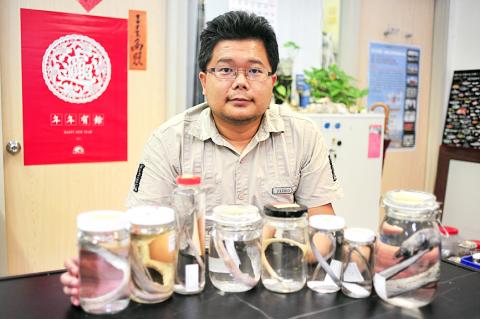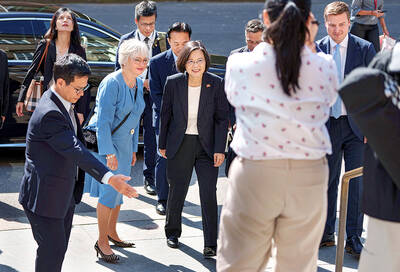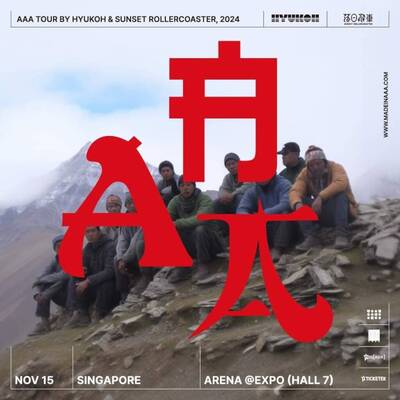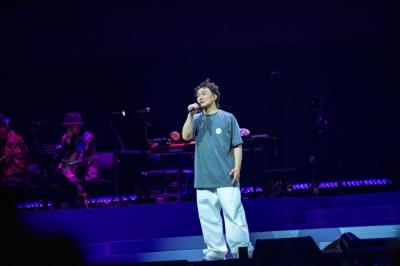A young associate researcher at the National Museum of Marine Biology and Aquarium has been making a name for himself and the country in the field of ichthyology, with two species named after him and having participated in the discovery of hundreds of new fish species in Taiwan.
Ho Hsuan-ching (何宣慶), 39, said he was able to discover so many new fish species by visiting markets around Taiwan.
Taiwan’s fish markets used to favor larger fish, while most of the small and medium-sized ones were either not sold or turned into fish balls, Ho said.

Photo: Tsai Tsung-hsien, Taipei Times
However, as fishery resources have declined, many types of fish that would not have been sold in the old days have found their way into local markets, he said.
“The rich variety of marine life around Taiwan is well known across the world,” said Ho, who has over the past decade found 30 new fish species in markets in Yilan's Dasi District (大溪), Yilan County’s Nanfangao Township (南方澳), and Pingtung County’s Donggang (東港) and Hengchun (恆春) townships.
Ho said he has also headed or participated in research that has documented more than 300 species of fish in Taiwan.
In 2005, Ho met with famed ichthyologist Margaret Bradbury in the US to consult her about classification of fish species. Bradbury, who had retired from teaching, gave him two large stacks of her research materials.
Ho said he returned the following year with his research results based on Bradbury’s data.
“Her eyes glowed,” when she saw his research, Ho said.
Bradbury passed away a few years later, Ho said.
To his suprise, he learned that her epitaph read: “An unexpected young man appeared to continue her research. That man was Ho Hsuan-ching.”
That made him feel that he was now responsible, as many people are “waiting for one man’s research,” Ho said.
While he has always taken pleasure in raising fish, Ho said he was embarrassed to admit that even with a degree in aquaculture, he usually ended up with a tank of dead fish.
“I felt that, rather than turning live fish into dead ones, I would be better off researching dead ones to begin with,” Ho said.
His love for fish has not diminished even though he now studies dead ones, Ho said, recounting one incident when he spent an entire night looking for the scientific name of a particular type of fish and his professor found him asleep on the floor of the research room the following morning.
Commenting on the two fish species named after him — the Pylorobranchus hoi and the Parapercis hoi — Ho said that the researchers were too kind.
The Pylorobranchus hoi was actually discovered by students led by professor Chen Hung-ming (陳鴻銘) of National Taiwan Ocean University in 2012, and he had been asked to ascertain whether it was a new species, Ho said.
He invited John McCosker, a California Academy of Sciences expert on ichthyology who was visiting Taiwan at the time, to help with the analysis.
He said he did not expect that Chen and the students would name the fish after him.
As for the Parapercis hoi, Ho said he had been working with the Queensland Museum in Australia’s Jeff Johnson since 2015 and was surprised when he learned that Johnson named one after him when he published five new species this year.
Ho has published more than 65 new fish species worldwide in his career and expects that number to rise to 75 by the end of this year.
He ranks second in Taiwanese academia for the number of fish species discovered.
A lack of information was one reason Taiwan was easily overlooked in the study of plant and animal life, he said.
It was not until the Indo-Pacific Fish Conference in 2005 that the world discovered Taiwan’s rich biodiversity, he said.
He and other Taiwanese academics have dedicated their efforts to increasing the nation’s global visibility through its fish species, Ho said.
Ichthyology is one area where political intervention is minimal, he added.
Ho’s studies on anglerfish have helped increase Taiwan’s visibility internationally, as information on anglerfish in fish atlases published by the Food and Agriculture Organization and other nations all carried his name.
“The name Taiwan is used in these books and it would never be mistaken for China,” Ho said, adding that he hopes to let more people learn the importance of marine conservation through education and discovery of new fish species.

Former president Tsai Ing-wen (蔡英文) on Monday called for greater cooperation between Taiwan, Lithuania and the EU to counter threats to information security, including attacks on undersea cables and other critical infrastructure. In a speech at Vilnius University in the Lithuanian capital, Tsai highlighted recent incidents in which vital undersea cables — essential for cross-border data transmission — were severed in the Taiwan Strait and the Baltic Sea over the past year. Taiwanese authorities suspect Chinese sabotage in the incidents near Taiwan’s waters, while EU leaders have said Russia is the likely culprit behind similar breaches in the Baltic. “Taiwan and our European

Taiwanese indie band Sunset Rollercoaster and South Korean outfit Hyukoh collectively received the most nominations at this year’s Golden Melody Awards, earning a total of seven nods from the jury on Wednesday. The bands collaborated on their 2024 album AAA, which received nominations for best band, best album producer, best album design and best vocal album recording. “Young Man,” a single from the album, earned nominations for song of the year and best music video, while another track, “Antenna,” also received a best music video nomination. Late Hong Kong-American singer Khalil Fong (方大同) was named the jury award winner for his 2024 album

Hong Kong singer Eason Chan’s (陳奕迅) concerts in Kaohsiung this weekend have been postponed after he was diagnosed with Covid-19 this morning, the organizer said today. Chan’s “FEAR and DREAMS” concert which was scheduled to be held in the coming three days at the Kaohsiung Arena would be rescheduled to May 29, 30 and 31, while the three shows scheduled over the next weekend, from May 23 to 25, would be held as usual, Universal Music said in a statement. Ticket holders can apply for a full refund or attend the postponed concerts with the same seating, the organizer said. Refund arrangements would

The Taipei District Court sentenced babysitters Liu Tsai-hsuan (劉彩萱) and Liu Jou-lin (劉若琳) to life and 18 years in prison respectively today for causing the death of a one-year-old boy in December 2023. The Taipei District Prosecutors’ Office said that Liu Tsai-hsuan was entrusted with the care of a one-year-old boy, nicknamed Kai Kai (剴剴), in August 2023 by the Child Welfare League Foundation. From Sept. 1 to Dec. 23 that year, she and her sister Liu Jou-lin allegedly committed acts of abuse against the boy, who was rushed to the hospital with severe injuries on Dec. 24, 2023, but did not